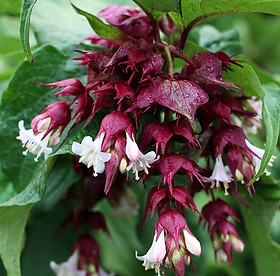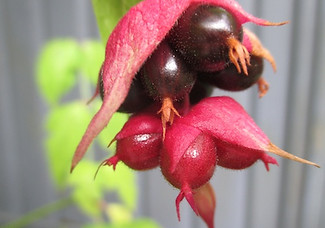

Ireland: Kerry - Dublin - Cork - Waterford - Roscommon - Galway - Belfast
UK: London - Manchester - Newcastle - Cardiff - Liverpool
Himalayan honeysuckle
Invasive Species Information

What Is Himalayan honeysuckle - (Leycesteria formosa)?
Habitat: Terrestrial. Typically found in hedgerows and on waste ground, occasionally found in woodland
Distribution in Ireland: Widespread with concentrations in the East and South East of Ireland
Status: Established
Family name: Caprifoliaceae
Common name/s: Pheasant-berry
Reproduction: Fruits are dispersed widely by birds and small mammals

Himalayan honeysuckle Flower

Himalayan honeysuckle Fruit/Berry
Himalayan Honeysuckle is a deciduous shrub and was originally introduced, in the Victorian era, from China and Tibet as an ornamental plant and often used as cover for pheasants.
The plant blooms from July to September. It produces berries in the autumn which are red at first, becoming black and subsequently eaten by birds.
Himalayan honeysuckle can often be observed along roadside routes throughout Ireland, with concentrations in the east and south east. it can also be found in areas of scrub, abandoned sites and shaded forest areas.
From mid- to late summer, 4 inch-long tassels of white flowers almost hidden by showy, wine-coloured bracts covering the plant, growing from the tips of the branches. These are followed by scented, deep red/purple berries in autumn.
Himalayan honeysuckle is a popular garden species, but in many areas, it has been caused to spread into the wild. Where Himalayan Honeysuckle has spread into the wild it is recommended that it is removed as it can quickly overwhelm native species.
How To Identify Himalayan honeysuckle?
![Himalayan honeysuckle [Pheasant berry] - Leycesteria formosa ID Guide V8](https://static.wixstatic.com/media/d4f7d5_b388a397af7440c5a3a0f0b8a689185d~mv2.png/v1/fill/w_519,h_367,al_c,q_85,usm_0.66_1.00_0.01,enc_avif,quality_auto/Himalayan%20honeysuckle%20%5BPheasant%20berry%5D%20-%20Leycesteria%20formosa%20ID%20Guide%20V8.png)
Himalayan honeysuckle - Leycesteria formosa ID Guide
Leaf: large, opposite, lanceolate
Flower: pale pink-purple, funnel-shaped with maroon bracts
Stem/Twig: soft and hollow, Purple/Red (woody)
Fruit: Initially deep red turning dark Purple/black
Height: up to 2.5m

Himalayan honeysuckle #3

Himalayan honeysuckle #4
Why Is Himalayan honeysuckle A Problem?
Himalayan honeysuckle is an alien (non-native) invasive plant, Forms dense thickets that can exclude native vegetation meaning it out-competes crowds-out and displaces beneficial native plants that have been naturally growing in Ireland for centuries.
European Communities (Birds and Natural Habitats) Regulations 2011 non-native invasive plant species A-Z (Updated 2017)
There are currently 35 invasive plant species listed in the European Communities (Birds and Natural Habitats) Regulations (annex 2, Part 1)...
Click on a species from the following list to find out more regarding non-native species subject to restrictions under Regulations 49 and 50.
-
American Skunk-Cabbage - Lysichiton americanus
-
Red Alga - Grateloupia doryphora
-
Wakame - Undaria pinnatifida
-
Waterweeds - Elodea (all species)
Additional Non-Native Plant Species identified as Medium Risk on Ireland's Biodiversity List...
Common name
Barberry
Black currant
Brazilian waterweed
Butterfly-bush
Canadian-fleabane
Clover broomrape
False acacia
Garden lupin
Giant rhubarb
Hairy rocket
Himalayan honeysuckle
Himalayan knotweed
Holm oak
Pampas grass
Pitcherplant
Red oak
Rock cotoneaster
Salmonberry
Sycamore
Three-cornered garlic
Traveler's-joy
Species name
Lysichiton americanus
Antithamnionella ternifolia
Ribes nigrum
Egeria densa
Buddleja davidii
Conyza canadensis
Codium fragile ssp. tomentosoides
Pseudotsuga menziesii
Solidago gigantea
Gunnera manicata
Persicaria wallichii
Lonicera japonica
Euphorbia esula
Acaena ovalifolia
Matteuccia struthiopteris
Sarracenia purpurea
Bunias orientalis
Environment
Terrestrial
Terrestrial
Terrestrial
Marine
Terrestrial
Terrestrial
Freshwater
Terrestrial
Terrestrial
Terrestrial
Terrestrial
Marine
Terrestrial
Terrestrial
Terrestrial
Terrestrial
Terrestrial
Terrestrial
Terrestrial
Terrestrial
Terrestrial
Terrestrial
Terrestrial
Terrestrial
Terrestrial
Terrestrial
Freshwater
Terrestrial
Terrestrial
Terrestrial
Terrestrial
Terrestrial
Terrestrial
Marine
Terrestrial
Terrestrial
Terrestrial
Terrestrial
Terrestrial
Terrestrial
Terrestrial
Terrestrial
Terrestrial
Terrestrial
Terrestrial
Terrestrial
Freshwater
Terrestrial
Risk score
14
15
17
15
14
14
17
17
14
17
16
16
15
14
17
17
17
16
17
14
16
14
14
15
14
16
14
16
14
14
14
14
14
14
14
17
14
14
14
15
15
17
17
14
16
15
14
15

